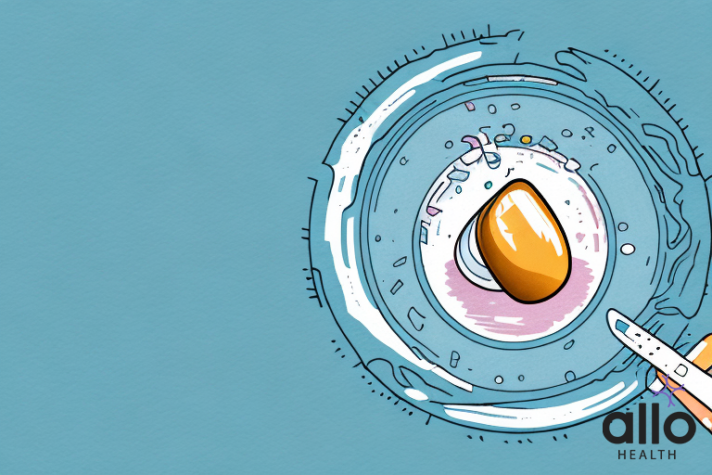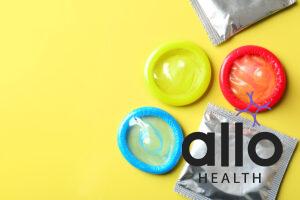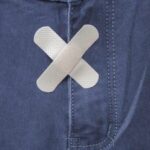How to Know If Sperm Has Leaked Out of a Condom

Allo Health is dedicated to personalized well-being, offering support and trusted information tailored to individual health goals. The platform emphasizes human-generated content, led by a distinguished medical team of experts, including physicians and sexual health specialists. Their commitment to credibility involves rigorous fact-checking, authoritative research, and continuous updates to ensure accurate, up-to-date information. Allo Health's unique approach goes beyond conventional platforms, providing expert-led insights and a continuous commitment to excellence, with user feedback playing a crucial role in shaping the platform's authoritative voice.

Dr. Nikunj Gokani is a practicing Psychiatrist with a postgraduate degree (MD) in Psychiatry. He completed his MBBS (Bachelor of Medicine, Bachelor of Surgery) from D Y Patil School of Medicine and his MD in Psychiatry from MGM Medical College and Hospital. In addition to his general psychiatry training, Dr. Gokani has also pursued a Fellowship in Clinical Sexology under the Guidance of illustrious goodman’s name Dr. Deepak Jumani at Sir JJ Hospital and Grant Medical college, Mumbai. Currently working with Dr. T S S Rao (world Renowned Psychiatrist and Sexologist) at JSS Medical College and Hospital, Mysore, he is a co-investigator on numerous clinical trials on various illness in psychiatry. Keeping up with new times and during pandemic, he has been using various virtual platforms for his own private practise. Due to his active participation in numerous events during his academic years, he also possesses exceptional organisational skills. Dr. Nikunj has to his name various publications as well. There is Hope, even when your brain tells you there isn't is the words that he lives by
Why This Was Upated?
Our experts continually monitor the health and wellness space, and we update our articles when new information became available.
Updated on 06 September, 2023
- Article was updated as part of our commitment to diversity, equity, and inclusion.

"The following blog article provides general information and insights on various topics. However, it is important to note that the information presented is not intended as professional advice in any specific field or area. The content of this blog is for general educational and informational purposes only.
Book consultation
The content should not be interpreted as endorsement, recommendation, or guarantee of any product, service, or information mentioned. Readers are solely responsible for the decisions and actions they take based on the information provided in this blog. It is essential to exercise individual judgment, critical thinking, and personal responsibility when applying or implementing any information or suggestions discussed in the blog."
Condoms are one of the most effective ways of reducing the risk of pregnancy and sexually transmitted infections during sexual intercourse. However, even with proper use, condoms can break or leak, leaving users at risk.
In this article, we will explain how to know if sperm has leaked out of a condom, why checking for leaks is crucial, and what to do if you suspect a condom has failed.
Why Checking for Leaks is Important
Condoms are thin, and small holes or tears can occur during manufacturing, storage or use. It is essential to check for condom leaks before and after sex because it determines the effectiveness of the condom.
- Condoms can be damaged by sharp objects, prolonged exposure to heat or direct sunlight.
- Checking for leaks before use, and regularly during sex helps to prevent the spread of sexually transmitted infections and unwanted pregnancies.
- Using oil-based lubricants can weaken the latex in condoms, making them more prone to breakage and leaks.Water-based or silicone-based lubricants are recommended for use with condoms to ensure their effectiveness.
- It is also crucial to use a new condom for each sexual act, as reusing a condom increases the risk of breakage and leaks.
By taking these precautions and regularly checking for leaks after intercourse, individuals can protect themselves and their partners from the transmission of sexually transmitted infections and unwanted pregnancies.
How to Check for Leaks in a Condom

- To check for sperm leakages after intercourse, hold the base or rim of the condom tightly and gently squeeze the tip.
- If any air is trapped, it should escape quickly in a uniform manner.
- A strong, steady stream of air means the condom has no holes or leaks, while a weak or interrupted stream indicates a tear or hole in the condom.
- Conduct this test multiple times against different light sources. It will help to detect tiny holes that might be invisible under normal light.
Condoms can also be damaged by exposure to heat, light, and friction. Always check the expiration date and storage instructions before using a condom.
Make sure to use a new condom for each sexual encounter to ensure maximum protection against sexually transmitted infections and unintended pregnancy.
The Risks of Not Checking for Leaks
- Not checking for leaks puts you at risk of unintended pregnancies and sexually transmitted infections. Sexually transmitted infections such as HIV, chlamydia, and gonorrhea pass from person to person via bodily fluids such as semen, vaginal fluid, and blood.
- If a condom breaks during intercourse, it allows semen to enter the vagina, which can lead to pregnancy.
Not all leaks are visible to the naked eye. Microscopic tears or holes in the condom can also occur, which can increase the risk of unintended pregnancy and sexually transmitted infections.
Therefore, it is recommended to not only visually inspect the condom before use, but also to use additional forms of protection such as spermicide or dental dams to further reduce the risk of transmission.
What to Do If You Suspect Sperm Has Leaked Out
If you suspect that sperm has leaked out of your condom, it is essential to take action quickly.
- Stop sexual intercourse and carefully remove the condom.
- Be gentle to avoid spilling any sperm.
- If possible, tie the condom knot and dispose of it.
- Take a shower or bath to clean up any additional semen that may have spilled.
- Finally, seek medical attention for sexually transmitted infection testing and emergency contraception.
Even if you have taken all the necessary precautions, there is still a chance of pregnancy or contracting a sexually transmitted infection.
Therefore, it is recommended to get tested regularly and use additional forms of contraception, such as birth control pills or condoms, to reduce the risk of unintended consequences.
Common Causes of Condom Breakage and Leakage
Condoms can break or leak for various reasons, including:
- Using expired condoms
- Incorrectly storing or carrying condoms
- Using non-water-based lubricants such as oil and lotion
- Being non-observant of the proper condom application process
- Misusing the condom during intercourse by reusing, putting it on backward or tearing it with nails and jewellery.
The size and fit of the condom can also contribute to breakage and leakage.
Using a condom that is too small or too large can increase the risk of it slipping off or tearing during intercourse.
It is recommended to choose a condom that fits properly and feels comfortable to ensure maximum protection.
How to Prevent Condom Breakage and Leakage

Proper condom application is crucial for preventing breakage and leakage. Some tips to ensure correct condom usage include:
- Checking the expiration date
- Storing condoms in a cool, dry place that is away from sharp objects or direct sunlight
- Using water-based lubricants to prevent tearing
- Following the application instructions as provided on the packaging
- Inspecting the condom for breaks or leaks before and after use
Note: Using two condoms at once does not provide extra protection. In fact, using two condoms can increase the likelihood of breakage and leakage due to the friction between the two layers. It is recommended to only use one condom at a time.
Communicate with your partner about condom usage. Both partners should be aware of the risks of sex without protection and the importance of using condoms consistently and correctly. Open communication can also help to ensure that both partners are comfortable and satisfied with the chosen method of protection.
Can You Get Pregnant if Sperm Leaked Out of a Condom?
The chances of getting pregnant if sperm leaks out of a condom are high. However, the rate of pregnancy depends on factors such as the timing of the leak after intercourse and whether the woman is ovulating. Semen can survive in the vagina for up to five days, which means that even a small number of live sperm can lead to fertilization.
Condoms are not 100% effective in preventing pregnancy. According to studies, the failure rate of condoms is around 2% with perfect use and 15% with typical use. This means that even if the condom did not break or tear, there is still a chance of pregnancy if sperm leaks out.
Additionally, using a condom is not only important for preventing unplanned pregnancy but also for protecting against sexually transmitted infections (STIs). Condoms are the only form of contraception that can provide protection against STIs.
When to Consider Emergency Contraception
If you suspect a condom leak, it is vital to err on the side of caution.
Emergency contraception such as the morning-after pill can help prevent pregnancy if taken within 72 hours after sex.
It’s essential to understand that emergency contraception options do not prevent sexually transmitted infections. Therefore, you have to get tested and treated for STDs.
Consider emergency contraception if you have missed taking your birth control pills or if you have had unprotected sex. Emergency contraception can be a safe and effective option to prevent pregnancy in these situations.
However, emergency contraception should not be used as a regular form of birth control and does not protect against STDs. It’s always best to use a barrier method of contraception, such as condoms, to prevent both pregnancy and STDs.
What to Expect During STD Testing After a Condom Breakage
If you’ve experienced condom breakage and suspect that you may have been exposed to sexually transmitted infections, you should get tested as a precautionary measure. STD testing involves a series of tests, including a blood test, urine test, and physical examination. The physicians might ask questions about your recent sexual experiences, assess your history of STDs, and guide you on what to do next in case of a positive result.
Final Words
Condom leaks and breaks are normal, and there are ways to prevent them. Always ensure you check for leaks before and after sex, and follow the correct procedure when storing and using condoms. In the event of a condom failure, emergency contraception and STD testing are vital to prevent unintended consequences.
Not all sexually transmitted infections show symptoms immediately after exposure. Some infections can take weeks or even months to manifest symptoms.
Therefore, it’s crucial to get tested regularly, even if you don’t experience any symptoms. Early detection and treatment of STDs can prevent long-term health complications and the spread of infections to others.
Frequently Asked Questions
Q: What happens when sperm enters vagina?
A: The egg cell fuses with the sperm cell that enters the female’s fallopian tube, forming a zygote, the first cell of a new individual. The zygote then travels to the uterus for implantation and further development.
Q: Will unprotected sex lead to increased chances of pregnancy?
A: Unprotected sex can lead to pregnancy if a healthy sperm, with sufficient sperm motility and sperm count, reaches and fertilizes a woman’s egg in her reproductive tract. Sperm motility enables them to swim effectively, while sperm count refers to the number of sperm present, increasing the chances of successful fertilization.
Q: How effective is pull-out method?
A: The pull-out method, also known as withdrawal method or “coitus interruptus,” is not a highly effective form of contraception. It has a high failure rate, as pre-ejaculate (pre-cum) can contain sperm, increasing the risk of unintended pregnancy.
Q: What are problems of condom use?
A: Some people may experience allergic reactions to latex or other materials used in condoms, leading to skin irritation, itching, or rash. Additionally, improper or inconsistent use of condoms can increase the risk of contraceptive failure and sexually transmitted infections (STIs).
Q: What is the best barrier protection?
A: The best barrier protection is a properly used latex or polyurethane condom, as they provide effective contraception and protection against sexually transmitted infections (STIs).





































